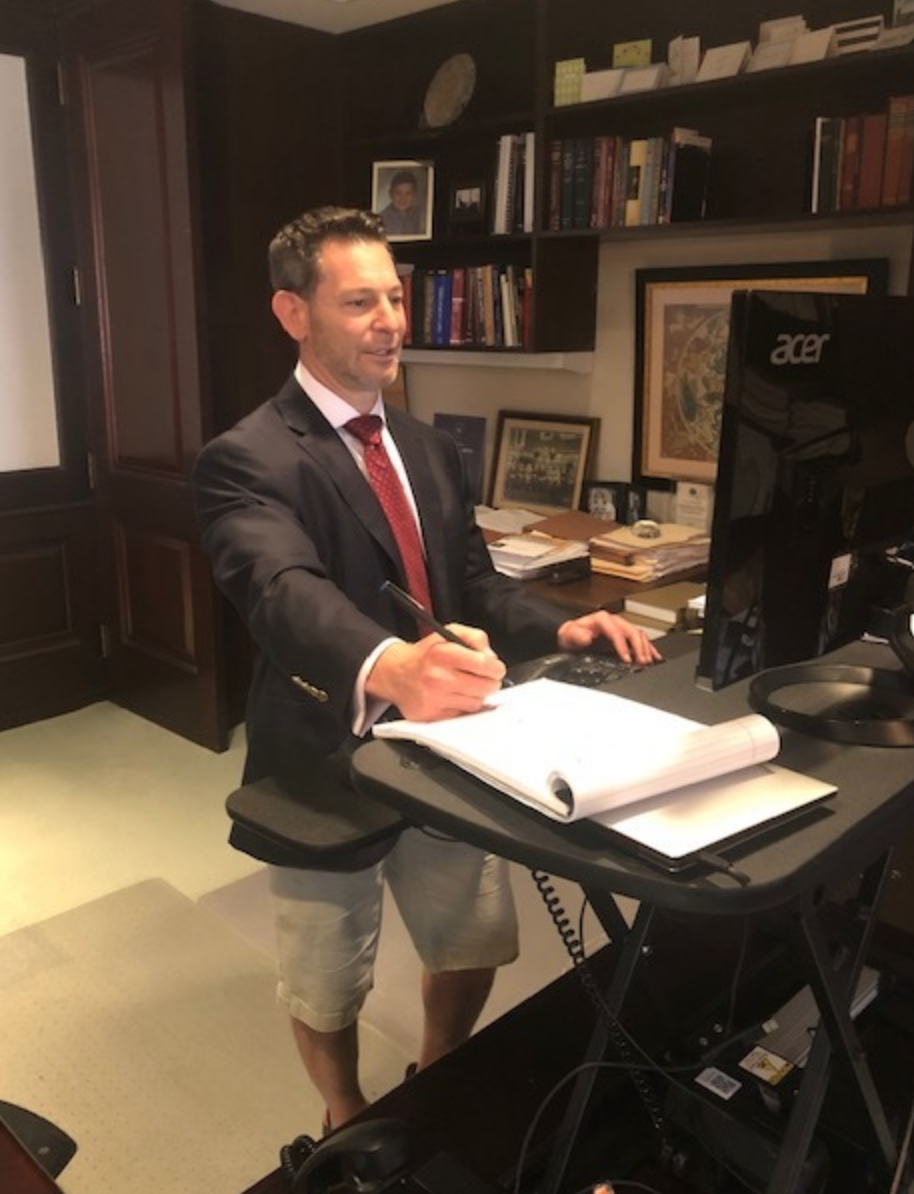Trial by Zoom: A strange but true story of how one lawyer prepared for court

David A. Lowe. Photo by Steve Murphy.
On June 12, I was in federal court cross-examining a witness about strawberry shortbread. Only, I wasn’t in the courthouse, and neither was the judge. The witness was my law partner, Michelle, and I wasn’t wearing pants.
We were doing a practice run 10 days before a trial in which everyone would be participating via Zoom videoconference because of the COVID-19 pandemic. Judge Edward Chen had invited all counsels to try out the court’s videoconference system to ensure that the remote trial would go smoothly.
The judge appeared for the practice run with a nifty Zoom virtual background that replicated his courtroom, along with the court reporter and clerk, in their respective remote locations. Opposing counsel dialed in from their conference room in Irvine, California, and my trial team assembled with appropriate distancing at our San Francisco office.
Because we did not want to preview the actual trial testimony, the practice run cross-examination consisted of me interrogating my partner Michelle about a strawberry shortbread recipe. When Michelle couldn’t remember the ingredients, we used Zoom’s “Share Screen” function to show her the recipe in order to refresh her recollection. Then we practiced integrating Zoom with our trial presentation software (OnCue) to show trial exhibits and play deposition video clips. It wasn’t perfect, but it was smooth enough to satisfy ourselves and Chen that we could pull this off.
A Zoom trial was not what I had in mind when we filed this case. We were looking forward to presenting the case to a jury. In September 2019, the court set a jury trial to begin June 22. At that time, we had no clue how much the world—and jury trials—would be upended by COVID-19.
By March 16, California and San Francisco had issued shelter-in-place orders because of the pandemic. The U.S. District Court for the Northern District of California (where the trial is set) canceled trials through May 1.
At an April 23 case management conference hosted via Zoom, Chen confirmed that a jury trial in June was likely out of the question but that the case could proceed as scheduled as a bench trial, either by videoconference or in person if public health guidance and the court’s orders at the time allowed it.
As counsel for the plaintiff, I had to make two agonizing decisions. First, my client and I had to decide whether to indefinitely delay the trial or to waive the jury and have the case decided by the judge. Second, when it became clear in May that COVID-19-related restrictions would prohibit an in-person bench trial in June, we had to decide whether to move forward by conducting the trial remotely by Zoom. To keep the case on track, we decided to do the trial remotely, rather than risk a potentially monthslong delay.
 David A. Lowe. Photo by S72 Business Portraits.
David A. Lowe. Photo by S72 Business Portraits.
Things got interesting when we began preparing to do an entire trial via videoconference. Our staff worked extra hard to make sure that the electronic trial exhibits were as clear as possible and available to the court via a document-sharing platform compliant with the court’s security requirements.
We loaded exhibits, deposition video excerpts and impeachment clips into the trial presentation software and began doing Zoom practice sessions with the trial team, making sure that we could smoothly move from live witness testimony to document exhibits to demonstrative exhibits to video clips. I also scheduled Zoom sessions with our client (who is in Colorado), so that he could get comfortable with the videoconference version of the direct exam.
We learned a lot. For example, while it was preferable to have my colleague, who was running the trial presentation software in the same room where I was conducting the witness examination, having two devices on the same Zoom call in one room created audio feedback, unless one of us was muted. Constantly muting and unmuting was interrupting the flow of the trial presentation, so we decided to separate everyone into different rooms.
Also, since the court’s Zoom system had disabled the “Chat” feature, we had to make sure that we could share the document exhibits with the court and witness in advance or use the Share Screen function. However, that process didn’t work if I was hosting the Zoom call on my iPad because the mobile-device version of Zoom lacked some of the functionality of the desktop and laptop versions.
Other Zoom functions were intact, however, including the ability to use preset virtual backgrounds. That resulted in one of my colleagues inadvertently appearing in court in front of a wolf howling at the moon before she realized it and turned off the virtual background.
I also learned that my trial presentation was much more polished if I was standing up instead of sitting at my desk, which meant buying a standing desk extension for my desk. I also invested in an external camera and microphone to improve the sound and video quality. We adjusted the lighting and made sure the background looked professional and courtroomlike.
The need to look professional, however, only extended a little past my shoulders. So I wore a suit coat and tie in camera range but shorts and sneakers below. It felt a little odd to be appearing before Chen without pants but definitely more comfortable.
Based on the strawberry shortbread practice session, I was confident that we were ready to try the case via Zoom. Although the trial ultimately did not go forward as scheduled, the preparations for our first federal court Zoom trial gave us the tools to be ready for the next case.
The ability to take cases to trial is critical, so that our clients can achieve closure either through the trial itself or because defendants are incentivized to settle in order to avoid the trial. Videoconference technology is giving us the ability to move forward and take cases to trial during the pandemic.
Of course, not every case is appropriate for a Zoom trial. For example, we are representing a young woman in a sexual assault case; that case was set for trial in Santa Clara County in April and was postponed indefinitely because of that court’s closure. I would be reluctant to waive a jury in that case or agree to a remote trial, given the importance to our client of telling her story.
However, given the extraordinary backlog of jury trials and the time it may take to get a civil case to a jury trial with social distancing precautions, the option of a Zoom trial will, in some cases, be the right choice. And for a while, it may be the only choice.
See also:
ABAJournal.com: “The Zoom boom: How videoconferencing tools are changing the legal profession”
David A. Lowe is a partner at the San Francisco-based law firm Rudy Exelrod Zieff & Lowe, where he litigates individual and class action employment matters on behalf of employees. In addition to representing clients, Lowe is also a neutral mediator with a highly successful record of assisting parties to resolve their disputes.
ABAJournal.com is accepting queries for original, thoughtful, nonpromotional articles and commentary by unpaid contributors to run in the Your Voice section. Details and submission guidelines are posted at “Your Submissions, Your Voice.”
Your Voice submissions

The ABA Journal wants to host and facilitate conversations among lawyers about their profession. We are now accepting thoughtful, non-promotional articles and commentary by unpaid contributors.

